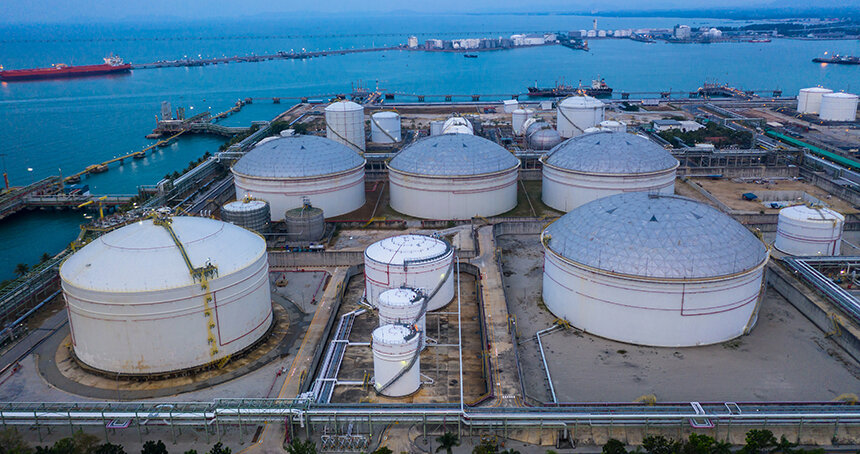
Liquefied natural gas is natural gas that has been cooled to a liquid state, at about minus 260 degrees Fahrenheit, for shipping and storage. (istock)
Rhode Island and Massachusetts among states that oppose the ruling
By TIM FAULKNER/ecoRI News staff
President Trump has followed through on his pledge to allow trains to transport liquefied natural gas (LNG), a decision opposed by environmental groups and 15 states, including Rhode Island and Massachusetts.
The U.S. Pipeline and Hazardous Materials Safety Administration (PHMSA) issued the final rule June 19. The regulation takes effect 30 days later.
Prior to the agency’s final decision, objections were raised via online comments from across the country. Washington Gov. Jay Inslee said the rule was illegal because it lacked required environmental and safety reviews.
“This proposed rule is rushed and ill-advised, and, if finalized, will pose a serious risk to public health and safety — not just in my state but nationwide,” Inslee said.
Others noted the health risks from a leak or fire, especially in densely populated urban areas. They accused PHMSA of rushing approval to benefit the domestic fracking industry.
“We must not be used as guinea pigs by this untested and high-consequence rush to grease the rails for special interests,” wrote Tamar Dick of Bethlehem, Pa.
Dick noted that LNG volume expands significantly when released in the air and is “capable of a far-reaching catastrophe, including a fire too hot to extinguish.”
PHMSA argued in its decision that the rule change was necessary to address regional inadequacies in natural-gas pipeline infrastructure. The federal agency said more natural gas is needed to satisfy growing domestic and international markets.
Train transportation, the agency maintained, is less risky than shipping by highway. LNG is similar to other flammable, cryogenic liquids currently transported by rail. The rule requires the use of an existing class of tank cars, called DOT-113, that is refrigerated and protected with a double-pressure vessel design.
The National Transportation Safety Board (NTSB), however, has refuted some of PHMSA’s claims, saying a thorough safety assessment of the DOT-113 tank cars is needed because the colorless, odorless gas is easily ignitable and hard to detect.
“Specifically, an analysis should address fireballs, flash fire, and explosions from ground-level vapor clouds that may expand far beyond the point of release to an ignition source,” according to a letter signed by Robert L. Sumwalt III, chairman of the NTSB.
The NTSB also noted that many more LNG tank cars will be traveling by rail than projected by PHMSA. Without added safety equipment and testing certifications, there isn’t enough data proving LNG can be transported safely, according to the safety board. The NTSB said lower train speed limits should be mandated in high-risk urban areas, special braking is needed, and training required to detect leaks and gas accumulations.
“We believe the risks of catastrophic LNG releases in accidents is too great not to have operational controls in place before large blocks of tank cars and unit trains proliferate,” Sumwalt said.
Sumwalt noted that derailments of DOT-113 tank cars, although rare, can release larger quantities of hazardous material than a truck accident, and that federal regulators have a poor track record of responding to “fiery flammable-liquids accidents.”
The Pennsylvania Independent Oil & Gas Association argued that the refrigerated rail cars have been proven safe to transport flammable cryogenic liquids such as ethylene and hydrogen. Increasing transportation options, the trade group argued, would allow natural-gas producers to make more money selling the fossil fuel around the world.
In a 43-page letter sent earlier this year, attorneys general from 15 states called for safety studies and a full environmental impact report. They noted that LNG would travel through densely populated areas in trains of up to 100 tank cars, on the same rail line used by high-speed passenger trains.
The “finding of no significant impact” by PHMSA, according to the letter, is fundamentally flawed and failed to consider the expected greenhouse-gas emissions attributable to the extraction and use of natural gas and the potential harm to public safety and the environment from accidental releases of LNG.
The letter explained that, in the event of a spill, vaporization creates an extremely cold, gaseous vapor cloud that can embrittle steel, cause severe burns, damage infrastructure, and further complicate an emergency response.
The Surfrider Foundation has pointed to a government study that put the hazard range of such a vapor cloud at more than 1.5 miles.
Under the new rule, there are no limits placed on where LNG trains can travel. Instead, the rail companies must evaluate 27 safety and security risk factors when considering potential routes.
The decision doesn’t mention frontline communities or health and environmental justice areas.
The other states objecting are California, Delaware, Illinois, Maryland, Michigan, Minnesota, New Jersey, New York, North Carolina, Oregon, Pennsylvania, Vermont, and Washington. The District of Columbia also opposes the rule.
"use" - Google News
June 28, 2020 at 02:09AM
https://ift.tt/2YEANRq
Feds Green Light Use of Trains to Transport LNG — ecoRI News - ecoRI news
"use" - Google News
https://ift.tt/2P05tHQ
https://ift.tt/2YCP29R
Bagikan Berita Ini














0 Response to "Feds Green Light Use of Trains to Transport LNG — ecoRI News - ecoRI news"
Post a Comment